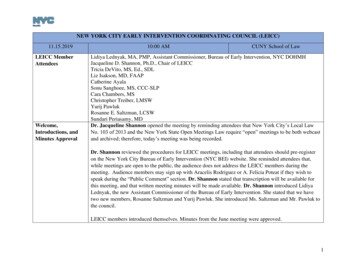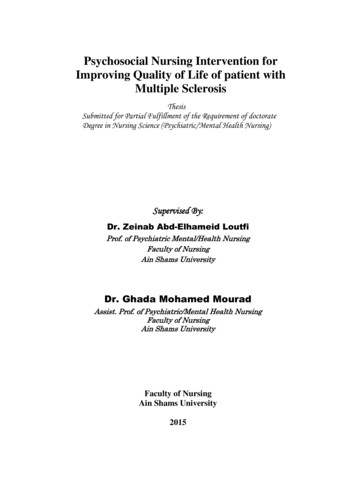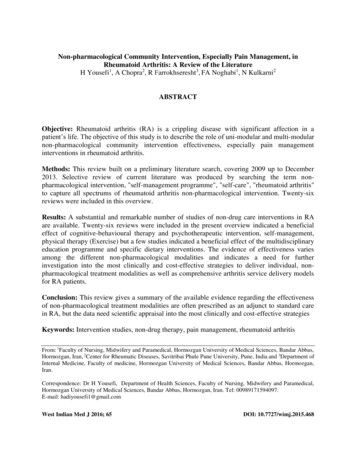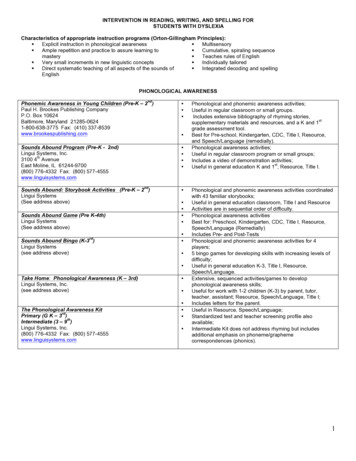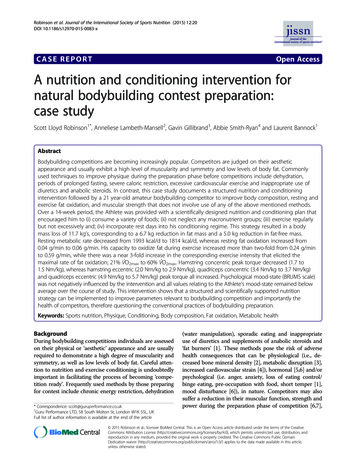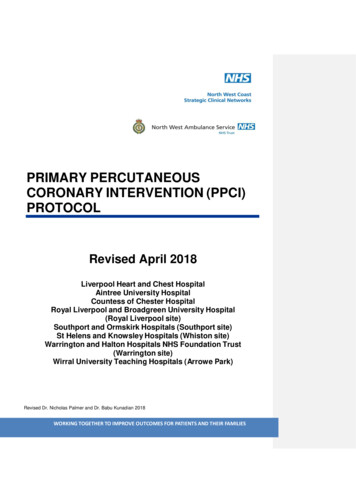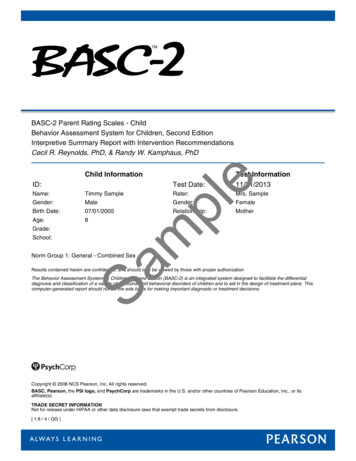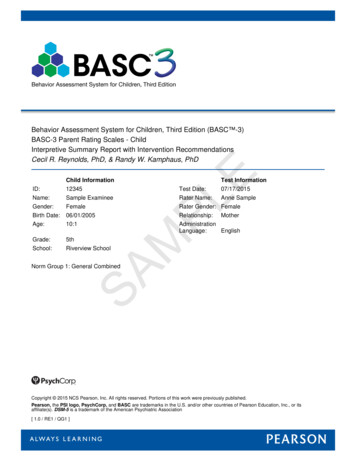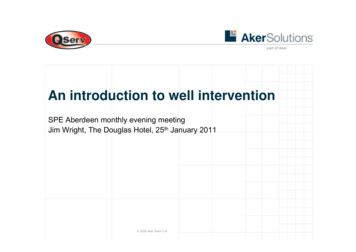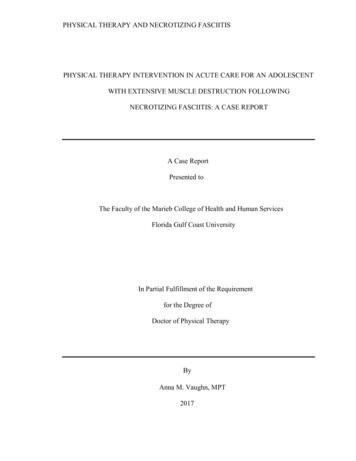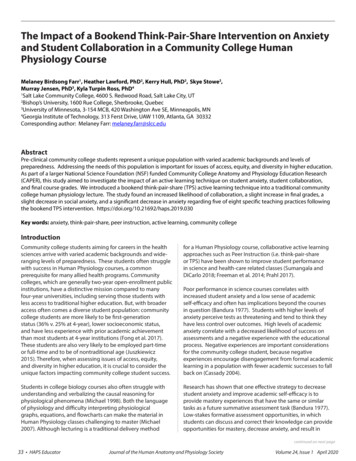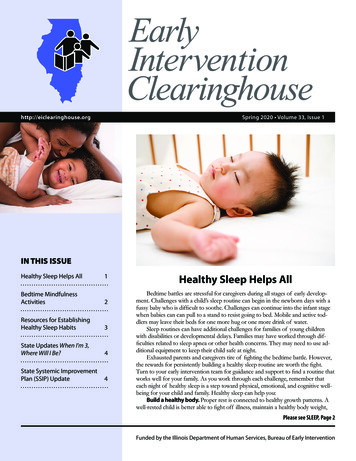
Transcription
se.org Spring 2020 Volume 33, Issue 1IN THIS ISSUEHealthy Sleep Helps All 1Bedtime MindfulnessActivities 2Resources for EstablishingHealthy Sleep Habits 3State Updates When I’m 3,Where Will I Be? 4State Systemic ImprovementPlan (SSIP) Update 4Healthy Sleep Helps AllBedtime battles are stressful for caregivers during all stages of early development. Challenges with a child’s sleep routine can begin in the newborn days with afussy baby who is difficult to soothe. Challenges can continue into the infant stagewhen babies can can pull to a stand to resist going to bed. Mobile and active toddlers may leave their beds for one more hug or one more drink of water.Sleep routines can have additional challenges for families of young childrenwith disabilities or developmental delays. Families may have worked through difficulties related to sleep apnea or other health concerns. They may need to use additional equipment to keep their child safe at night.Exhausted parents and caregivers tire of fighting the bedtime battle. However,the rewards for persistently building a healthy sleep routine are worth the fight.Turn to your early intervention team for guidance and support to find a routine thatworks well for your family. As you work through each challenge, remember thateach night of healthy sleep is a step toward physical, emotional, and cognitive wellbeing for your child and family. Healthy sleep can help you:Build a healthy body. Proper rest is connected to healthy growth patterns. Awell-rested child is better able to fight off illness, maintain a healthy body weight,Please see SLEEP, Page 2Funded by the Illinois Department of Human Services, Bureau of Early Intervention
As Your Child Grows, Sleep Habits ChangeHere are the changes in sleep patterns you can expect as your child develops.Birth to 12 monthsMost newborns will fall asleep easily.They sleep 16–18 hours per day,but may only sleep 1–2 hours at atime. Their sleep pattern can be veryunpredictable.By 3–4 months, babies may startsleeping through the night. Theirsleep may appear restless, with alot of movement, twitching, noises,smiling, and sucking. But don’tworry—this is normal.SLEEPContinued from Page Oneand have better overall physical health.Certain hormones that help with the repair and growth of cells are only releasedduring deep sleep.Boost brain development. Thebrains of infants and toddlers are growing and active during sleep. Sleep is when12–24 monthsThe need for sleep decreases duringthis time. Most toddlers needbetween 12 and 14 hours of sleep,including naptime.Children may begin asking you toread, and reread, a favorite book orbooks.By 12–18 months, many childrenbegin to give up the morning napand transition to a longer afternoonnap.the brains of young children are activelyworking through memories and cognitive processes and even solidifying theunderlying brain processes for physicaldevelopment.Support self-regulation. Selfregulation refers to how the brain andbody work together to control emotions,attention, and thoughts. A well-restedchild has an easier time coping with bigemotions and transitions throughout the24–36 monthsToddlers need about 13–14 hours ofsleep throughout a day, including anap.A toddler may be ready for a biggerbed.Toddlers may try to delay bedtimeby requesting drinks, asking formore hugs and kisses, or “just onemore” book.day. Proper rest helps children sustainattention when they are exploring newthings and learning about their worldthrough play.Improve overall family health. Research also indicates that the whole family’s health is improved when parents andother adults who live with young childrenget healthy sleep. Consider the needs ofthe whole family for rest when planning asleep routine for young children.Bedtime Mindfulness ActivitiesAfter the lights are low and thebooks are put away, try using a guidedmeditation to help ease the transition tosleep. Bedtime meditations can be veryhelpful to calm down the nervous system and decrease a child’s level of stresshormones. Tuck your child into bedand gently rub their back or simplystand nearby and use your voice toguide them into slumber. Try one ofthese guided mindfulness stories at yourchild’s next bedtime:The Floaty BoatFor this exercise begin by encouraging your child to imagine him or herselfwrapped in a warm blanket in the bottom of a little boat. You might wantto place the boat near to the banks ofa small river to add a sense of safety,perhaps put yourself in the boat, too.You can begin, “We are snuggled under2Sleepy Cats (or Any OtherSnuggly, Sleepy Animal)a fleecy blanket, in our little boat, undera starlit sky.” Bring different senses intoplay—the gentle bobbing sensation, asoft breeze, rustling leaves, the murmurof the water as it flows over rocks. Imitate watery sounds with words such ashush and shush as you gently drift downstream—and your child gently drifts offto sleep.Begin by quietly describing andimagining a cat, maybe a small, whitesleepy kitten, or a big, silver tabby, usinggentle words such as soft and fluffy, andgive it a sleepy sounding name such as“Dreamy.” Then talk slowly about howcomfortable Dreamy feels, how shepurrs and stretches as she snoozes onthe bed. Other cats may also climb ontothe bed. Repeating words and phrasessuggestive of sleep can be really effectiveat bedtime. It’s a technique used to greateffect by Swedish psychologist CarlJohan Forssén Ehrlin in the bestsellingbook The Rabbit Who Wants to Fall Asleep.Adapted from “7 Guided Meditations toHelp Your Child Fall Asleep” at p-your-child-sleep-2559472493
Establishing Healthy Sleep HabitsHealthy sleep habits can help a child feel safe and secure. A baby’s sleep patterns are constantly changing as aresult of his or her development. Here are some ways you can create good sleep habits. Have a predictablesleep routine thatmight includea bath, feeding,diaper change,songs, and books.The nap routinewill be shorterand less involved.This signals toyour child that thetime to sleep isapproaching. Wait a fewminutes to see ifhe can go back tosleep if he wakesduring the night.If not, check onhim but leave thelights low. He maybe hungry or wet. Have a setbedtime andwake-uptime—even onweekends. Create a quiet,dark, and nottoo warm sleepenvironment. Consider using adim night-lightto help your childfeel more secure. Adjust naps tosupport yourchild’s bedtimeschedule. Always put a babydown to sleep onhis or her backon a firm surfacewith no pillows,comforters, cribbumpers, or softstuffed animals. Avoid putting achild to bed with abottle. If sleep problemspersist, contactyour health careprovider becausethere may bean underlyingmedical issue. Put your baby tobed drowsy, butawake. This helpsher learn to fallasleep on herown.For more information, visit the Illinois Early Intervention Clearinghouse at https://eiclearinghouse.orgAny opinions, findings, conclusions, or recommendations expressed in this publication are those of the author(s) and do not necessarilyreflect the views of the Illinois Department of Human Services, Bureau of Early Intervention.Funded by the IllinoisDepartment of Human ServicesBureau of Early ouseIllinois Early Intervention ClearinghouseEarly Childhood CollectiveUniversity of Illinois at Urbana-ChampaignChildren’s Research Center51 Gerty Dr. Champaign, IL 61820-7469Telephone: (217) 333-1386 Toll-free: (877) 275-3227E-mail: Illinois-eic@illinois.edu
Resources for Establishing Healthy Sleep HabitsThe Natural Baby Sleep Solution:Use Your Child’s Internal SleepRhythms for Better Nights andNapsPolly MooreWorkman, 2016WM 188 .M7811 2008Happiest Baby Guideto Great Sleep: SimpleSolutions for Kids fromBirth to 5 YearsHarvey KarpWilliam Morrow, 2012WM 188 .K1481 2012Sleep Better! A Guide to ImprovingSleep for Children with Special NeedsV. Mark DurandPaul H. Brookes, 2013WM 188 .D931 2014Also available as an eBookOn Becoming BabyWise: Giving Your Infantthe Gift of Nighttime SleepGary EzzoParent-Wise Solutions,2019WM 188 .E993 2019Healthy Sleep Habits,Happy Child: A Step-byStep Program for a GoodNight’s SleepMark WeissbluthBallantine Books, 2015WM 188 .W432 2015VideosThe Happiest Baby on theBlock64 minutes, DVDHappiest Baby, 2012WM 188 .K148dvd 2012Pediatric Sleep Problems: A Clinician’s Guide toBehavioral InterventionsLisa J. MeltzerAmerican Psychological Association, 2015WM 188 .M496 2015The Brain: Activity, Sleepand Boredom20 minutes, DVDLearning ZoneXpress, 2011QP 376 .B73asb 2011The Happiest Baby on theBlock: The New Way toCalm Crying and Help YourNewborn Baby Sleep LongerHarvey KarpPenguin Random House,2015WM 188 .K148 2015Also available as an eBookMayo Clinic Guide to Your Baby’s First YearDa Capo Press, 2012WS 105 .M4545 2012eBooks Are Here!You can now check out anddownload eBooks instantly, usingthe cloudLibrary or Overdrive appon most devices. For moredetailed instructions, visiteiclearinghouse.org/resources/library/ebooks/ or click on oneof the icons on the right.3
State Updates WhenI’m 3, Where Will I Be?Transitions happen all around us. As parents, bringing our child home from the hospital is the first ofmany enormous transitions we will encounter. Thenthere will be transitions into child care, into schools,and between different teachers. The formal transitionfrom early intervention services begins when a child is2½ years old.When I’m 3, Where Will I Be? is the transition workbook developed by parents and professionals in Illinoisto provide information to families who are preparingfor the transition out of early intervention services topossibly receiving services through their local schooldistrict.This book addresses only one transition, but thisparticular one can be scary as young children and theirfamilies are moving from a “known” system into an“unknown” system.This book describes the process, includes checkliststo help throughout the process, outlines the transitiontimeline, and provides tips, strategies, and talking pointsfor families to help with a more smooth transition.This book can be accessed from the Illinois StateBoard of Education page at on workbook.pdf.The book and accompanying resources can also beordered for free from the Child Find page at https://www.childfind-idea-il.us/Default.aspxState Systemic Improvement Plan (SSIP) UpdateAs we head into the final year of our SSIP, we continue to focus on familyengagement as a way to enhance families’ capacity to meet the developmentalneeds of their infants and toddlers. Our pilot sites continue to improve their capacity to implement family-centered services through growing leadership teamcapacity and supporting local teams with training and support.As more teams use coaching strategies that build on family strengths, weget closer to our vision of a system that truly supports families in their effortsto help their children develop and learn and leads to infants’ and toddlers’ improved acquisition and use of knowledge and skills.While some of the activities in our plan have unfortunately been delayed,we will continue to move forward when it is safe to do so. Though we couldnot have anticipated the circumstances, the recent shift in service delivery hasrequired interventionists to use coaching skills and support strategy use duringfamilies’ daily routines. We are hopeful that these opportunities will help familiescontinue to meet their outcomes while staying safe!Follow Us on Facebook and Twitter!Receive regular updates on library news, resourceson the Web, and materials at our seIllinois Early InterventionClearinghouseEarly Childhood CollectiveCollege of EducationUniversity of Illinois at Urbana-ChampaignChildren’s Research Center51 Gerty DriveChampaign, IL 61820-7469Phone: 877-275-3227 (in Illinois)Principal investigator: Meghan BurkeContributors: Sarah Isaacs, RebeccaSwartz, Jill Tompkins, ChelseaGuillen, & Meghan BurkeOpinions expressed in Early Interventionare the responsibility of the author andare not necessarily those of the IllinoisDepartment of Human Services or theUniversity of Illinois at Urbana-Champaign.Early Intervention Clearinghouse(ISSN 1058-8396) is published quarterly.
Always put a baby down to sleep on his or her back on a firm surface with no pillows, comforters, crib bumpers, or soft stuffed animals. Put your baby to bed drowsy, but awake. This helps her learn to fall asleep on her own. Wait a few minutes to see if he can go bac

